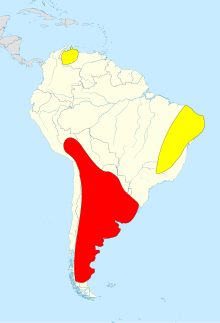| Macrauchenia Temporal range:
| |
|---|---|

| |
| Skeleton of M. patachonica (larger) and Phenacodus primaevus (smaller) at American Museum of Natural History | |
| Scientific classification | |
| Domain: | Eukaryota |
| Kingdom: | Animalia |
| Phylum: | Chordata |
| Class: | Mammalia |
| Order: | †Litopterna |
| Family: | †Macraucheniidae |
| Subfamily: | †Macraucheniinae |
| Genus: | †Macrauchenia Owen, 1838 |
| Type species | |
| †Macrauchenia patachonica Owen, 1838
| |

| |
| Map showing the distribution of Macrauchenia in red, and Xenorhinotherium in yellow, inferred from fossil finds | |
Macrauchenia ("long llama", based on the now-invalid llama genus, Auchenia, from Greek "big neck") is an extinct genus of large ungulate native to South America from the Pliocene[1] or Middle Pleistocene to the end of the Late Pleistocene.[2] It is a member of the extinct order Litopterna, a group of South American native ungulates distinct from the two orders which contain all living ungulates which had been present in South America since the early Cenozoic, over 60 million years ago, prior to the arrival of living ungulates in South America around 2.5 million years ago as part of the Great American Interchange.[3] The bodyform of Macrauchenia has been described as similar to a camel,[4] being one of the largest-known litopterns, with an estimated body mass of around 1 tonne.[3] The genus gives its name to its family, Macraucheniidae, which like Macrauchenia typically had long necks and three-toed feet, as well as a retracted nasal region,[5] which in Macrauchenia manifests as the nasal opening being on the top of the skull between the eye sockets.[6] This has historically been argued to correspond to the presence of a tapir-like proboscis, though recent authors suggest a moose-like prehensile lip[7] or a saiga antelope-like nose to filter dust are more likely.
Only one species is generally considered valid,[8] M. patachonica, which was described by Richard Owen based on remains discovered by Charles Darwin during the voyage of the Beagle.[9] M. patachonica is primarily known from localities in the Pampas, but is known from remains found across the Southern Cone extending as far south as southernmost Patagonia, and as far north as Southern Peru. Another genus of macraucheniid Xenorhinotherium was present in northeast Brazil and Venezuela during the Late Pleistocene.[6]
Macrauchenia is thought to have been a mixed feeder that both consumed woody vegetation and grass that lived in herds and probably engaged in seasonal migrations. Macrauchenia is suggested to have been a swift runner that was capable of moving at considerable speed.
Macrauchenia became extinct as part of the end-Pleistocene extinction event around 12,000 years ago, along with the vast majority of other large mammals native to the Americas.[3] This followed the arrival of humans to the Americas, and possible evidence of human interactions with Macrauchenia has been found at a number of sites with some authors suggesting human hunting may have played a role in its extinction.
- ^ Püschel, Hans P; Shelley, Sarah L; Williamson, Thomas E; Perini, Fernando A; Wible, John R; Brusatte, Stephen L (2024-09-02). "A new dentition-based phylogeny of Litopterna (Mammalia: Placentalia) and 'archaic' South American ungulates". Zoological Journal of the Linnean Society. 202 (1). doi:10.1093/zoolinnean/zlae095. ISSN 0024-4082.
- ^ Püschel, Hans P.; Martinelli, Agustín G. (December 2023). "More than 100 years of a mistake: on the anatomy of the atlas of the enigmatic Macrauchenia patachonica". Swiss Journal of Palaeontology. 142 (1): 16. Bibcode:2023SwJP..142...16P. doi:10.1186/s13358-023-00279-1. ISSN 1664-2376.
- ^ a b c Croft, Darin A.; Gelfo, Javier N.; López, Guillermo M. (2020-05-30). "Splendid Innovation: The Extinct South American Native Ungulates". Annual Review of Earth and Planetary Sciences. 48 (1): 259–290. Bibcode:2020AREPS..48..259C. doi:10.1146/annurev-earth-072619-060126. ISSN 0084-6597. S2CID 213737574.
- ^ Defler, Thomas (2019), "The Native Ungulates of South America (Condylarthra and Meridiungulata)", History of Terrestrial Mammals in South America, Topics in Geobiology, vol. 42, Cham: Springer International Publishing, pp. 89–115, doi:10.1007/978-3-319-98449-0_5, ISBN 978-3-319-98448-3, S2CID 91879648, retrieved 2024-01-30
- ^ Püschel, Hans P.; Alarcón-Muñoz, Jhonatan; Soto-Acuña, Sergio; Ugalde, Raúl; Shelley, Sarah L.; Brusatte, Stephen L. (June 2023). "Anatomy and phylogeny of a new small macraucheniid (Mammalia: Litopterna) from the Bahía Inglesa Formation (late Miocene), Atacama Region, Northern Chile". Journal of Mammalian Evolution. 30 (2): 415–460. doi:10.1007/s10914-022-09646-0. ISSN 1064-7554.
- ^ a b de Oliveira, Karoliny; Araújo, Thaísa; Rotti, Alline; Mothé, Dimila; Rivals, Florent; Avilla, Leonardo S. (March 2020). "Fantastic beasts and what they ate: Revealing feeding habits and ecological niche of late Quaternary Macraucheniidae from South America". Quaternary Science Reviews. 231: 106178. Bibcode:2020QSRv..23106178D. doi:10.1016/j.quascirev.2020.106178. S2CID 213795563.
- ^ Moyano, Silvana Rocio; Giannini, Norberto Pedro (November 2018). "Cranial characters associated with the proboscis postnatal-development in Tapirus (Perissodactyla: Tapiridae) and comparisons with other extant and fossil hoofed mammals". Zoologischer Anzeiger. 277: 143–147. Bibcode:2018ZooAn.277..143M. doi:10.1016/j.jcz.2018.08.005. hdl:11336/86349.
- ^ Souza Lobo, Leonardo; Lessa, Gisele; Cartelle, Cástor; and Romano, Pedro S. R. (September 2017). "Dental eruption sequence and hypsodonty index of a Pleistocene macraucheniid from the Brazilian Intertropical Region". Journal of Paleontology. 91 (5): 1083–1090. Bibcode:2017JPal...91.1083S. doi:10.1017/jpa.2017.54. ISSN 0022-3360.
- ^ Fernicola, Juan C., Vizcaino, Sergio F., & De Iuliis, Gerardo (2009). The fossil mammals collected by Charles Darwin in South America during his travels on board the HMS Beagle. Revista De La Asociación Geológica Argentina, 64(1), 147-159. Retrieved from https://revista.geologica.org.ar/raga/article/view/1339